How Simrad Halo works, 12 radars in one!
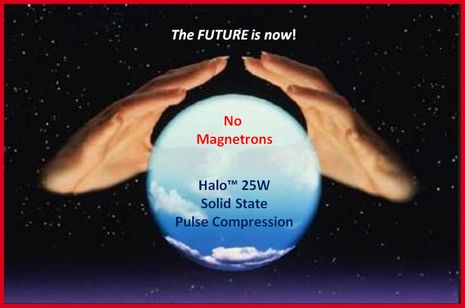 Panbo’s first entry about Simrad’s unique solid-state open-array Halo radar tried to cover the promised features. Now I’ll try to explain how it works, with the huge benefit of slides made available to me by Navico sr. product manager and engineer Don Korte, who I first met when Broadband (3G/4G) radar was introduced in 2009. I’m starting with the image above because that’s not just Navico marketing; it would be hard to overstate Don’s enthusiasm for Halo as he led me through the presentation. It was a teleconference but I’m pretty sure he was jumping up and down as I slowly got some of the concepts and he answered my smarter questions with a hearty “YES!”…
Panbo’s first entry about Simrad’s unique solid-state open-array Halo radar tried to cover the promised features. Now I’ll try to explain how it works, with the huge benefit of slides made available to me by Navico sr. product manager and engineer Don Korte, who I first met when Broadband (3G/4G) radar was introduced in 2009. I’m starting with the image above because that’s not just Navico marketing; it would be hard to overstate Don’s enthusiasm for Halo as he led me through the presentation. It was a teleconference but I’m pretty sure he was jumping up and down as I slowly got some of the concepts and he answered my smarter questions with a hearty “YES!”…
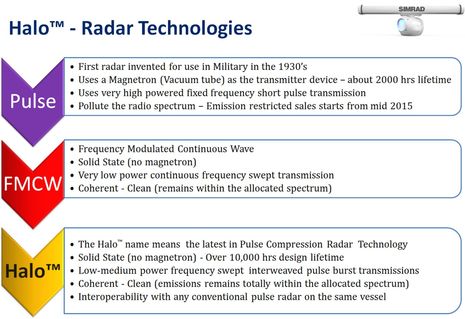 I got a little carried away with the number of slides I’m using, but many are self explanatory, or nearly so, like this beginning breakdown of how Halo compares to traditional magnetron pulse marine radar and the FMCW transmit technology used in 3G/4G radomes. I will note that modern magnetron radars are “clean” enough to pass the upcoming emission restrictions, to my knowledge, and that was explicitly stated for Furuno radars in a recent PMY article about Halo
I got a little carried away with the number of slides I’m using, but many are self explanatory, or nearly so, like this beginning breakdown of how Halo compares to traditional magnetron pulse marine radar and the FMCW transmit technology used in 3G/4G radomes. I will note that modern magnetron radars are “clean” enough to pass the upcoming emission restrictions, to my knowledge, and that was explicitly stated for Furuno radars in a recent PMY article about Halo
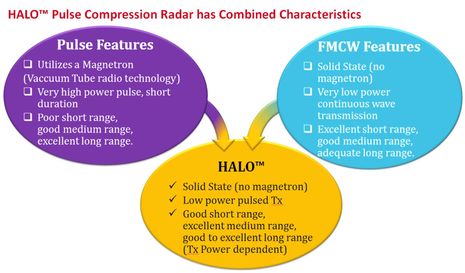 Halo tries to combine the features of magnetron pulse with those of 3G/4G FMCW, and I find it reassuring that Navico humbly terms 3G/4G long range performance as “adequate.” That’s been its Achilles Heel. I also note that they’re calling Halo’s long range performance “good to excellent.” I know they did extensive A/B testing with the best open-array radars from all the major brands, and I gather that it’s not quite as good as some at distance. However, I think you will be impressed with some of the screenshots way below.
Halo tries to combine the features of magnetron pulse with those of 3G/4G FMCW, and I find it reassuring that Navico humbly terms 3G/4G long range performance as “adequate.” That’s been its Achilles Heel. I also note that they’re calling Halo’s long range performance “good to excellent.” I know they did extensive A/B testing with the best open-array radars from all the major brands, and I gather that it’s not quite as good as some at distance. However, I think you will be impressed with some of the screenshots way below.
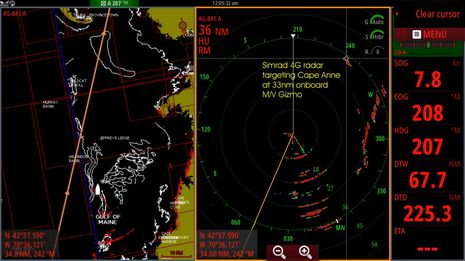 But first here’s a Simrad 4G radar screenshot I took on Gizmo last September while making a night passage from Maine to the Cape Cod Canal. The steep, stony northeast coast of Cape Anne is a great target — and I saw or would expect performance as good or better from the 3 HD magnetron radars onboard, even the 2kW Furuno — but I’d say that a consistent 33nm range is at least “adequate.”
But first here’s a Simrad 4G radar screenshot I took on Gizmo last September while making a night passage from Maine to the Cape Cod Canal. The steep, stony northeast coast of Cape Anne is a great target — and I saw or would expect performance as good or better from the 3 HD magnetron radars onboard, even the 2kW Furuno — but I’d say that a consistent 33nm range is at least “adequate.”
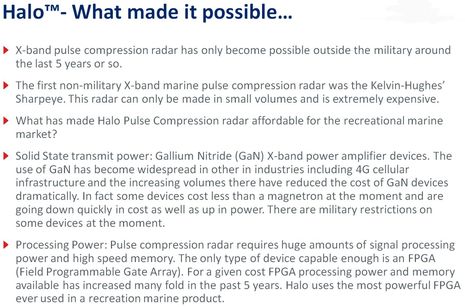 Apparently, Broadband/3G/4G radar was only possible at a recreational marine price because a certain solid-state driver became available at reasonable cost, and the same is true of Halo. My eyes start to roll when trying to understand Gallium Nitride (GaN) amps, etc., but I couldn’t miss Don Korte’s extra enthusiasm when talking about the processing horsepower available in Halo’s Field Programmable Gate Array (FPGA), which was apparently just barely affordable given Simrad’s desire to sell Halo at competitive prices. (And at $4,500, $5,000, and $5,500 retail for the 3-, 4-, and 6-foot Halo models, Simrad seems to have hit their marks.)
Apparently, Broadband/3G/4G radar was only possible at a recreational marine price because a certain solid-state driver became available at reasonable cost, and the same is true of Halo. My eyes start to roll when trying to understand Gallium Nitride (GaN) amps, etc., but I couldn’t miss Don Korte’s extra enthusiasm when talking about the processing horsepower available in Halo’s Field Programmable Gate Array (FPGA), which was apparently just barely affordable given Simrad’s desire to sell Halo at competitive prices. (And at $4,500, $5,000, and $5,500 retail for the 3-, 4-, and 6-foot Halo models, Simrad seems to have hit their marks.)
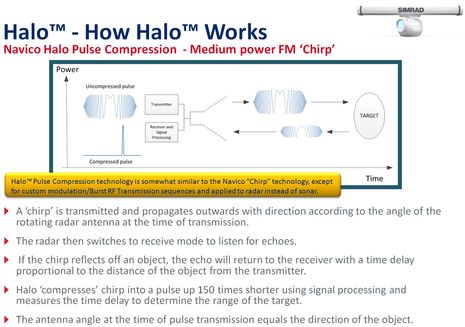 It’s my understanding that the CHIRP-like pulse compression is a common way to do solid-state radar in other fields and in the commercial marine radars that have come out (like Furuno’s FAR3000 S-band option). Plus, I gather that Navico is only claiming intellectual property rights on some tangential aspects of Halo (which may be good news for the future of marine radar). But man, it sure looks like they did a lot to make it work well.
It’s my understanding that the CHIRP-like pulse compression is a common way to do solid-state radar in other fields and in the commercial marine radars that have come out (like Furuno’s FAR3000 S-band option). Plus, I gather that Navico is only claiming intellectual property rights on some tangential aspects of Halo (which may be good news for the future of marine radar). But man, it sure looks like they did a lot to make it work well.
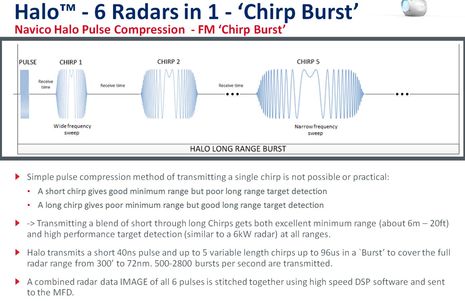 Compressed pulses can effectively be much longer than magnetron pulses, which is part of how a 25W Halo can approach the reach of a 6kW maggie. But even magnetron “long” pulses aren’t good at short ranges. In fact, when I was first taught radar (on a 160-foot offshore oil field boat in the 70’s), I was told to regularly range in so I didn’t miss any close targets. Modern magnetron radars have gotten better in this regard, but certainly not perfect, and the “extra long” Halo pulses were a definite problem. So Halo transmits bursts of pulses, up to six when set to full range. What’s more, after processing each individual pulse, it then draws the target image by stitching together the results of the short pulses for near ranges and longer pulses for further away.
Compressed pulses can effectively be much longer than magnetron pulses, which is part of how a 25W Halo can approach the reach of a 6kW maggie. But even magnetron “long” pulses aren’t good at short ranges. In fact, when I was first taught radar (on a 160-foot offshore oil field boat in the 70’s), I was told to regularly range in so I didn’t miss any close targets. Modern magnetron radars have gotten better in this regard, but certainly not perfect, and the “extra long” Halo pulses were a definite problem. So Halo transmits bursts of pulses, up to six when set to full range. What’s more, after processing each individual pulse, it then draws the target image by stitching together the results of the short pulses for near ranges and longer pulses for further away.
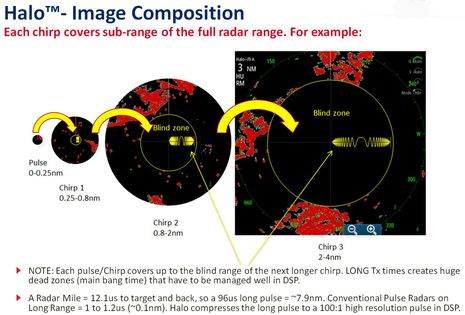 So, yes indeed, Simrad has good reason to call Halo “six radars in one,” and it seems like quite an accomplishment. When you’re looking at this radar in any range beyond .25nm — which is actually handled by a very short pulse, not CHIRPed — you’re seeing more than one set of pulse interpretations, up to six. No matter the range, close targets should show (if your screen has enough pixels). Apparently one of the major challenges was getting targets that sit on a pulse/range border to look right even though they’re “stitched” together.
So, yes indeed, Simrad has good reason to call Halo “six radars in one,” and it seems like quite an accomplishment. When you’re looking at this radar in any range beyond .25nm — which is actually handled by a very short pulse, not CHIRPed — you’re seeing more than one set of pulse interpretations, up to six. No matter the range, close targets should show (if your screen has enough pixels). Apparently one of the major challenges was getting targets that sit on a pulse/range border to look right even though they’re “stitched” together.
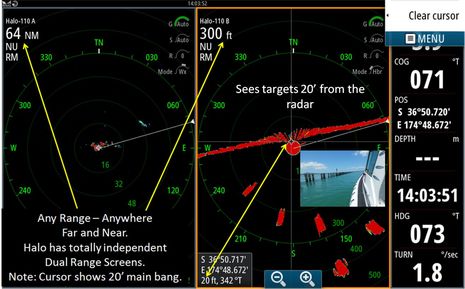 The pulse burst technology is purportedly also great for dual range mode, which Navico had already developed nicely in the 4G radome. Even if you’re in the Halo-4’s maximum 64nm range, the radar is already looking at the minimum 300 ft range pulses, and so it’s just a matter of setting up the second window and permitting individual controls or modes. Note that in this dual range screen the long range is in Wx mode while the near one is in Hbr. And note that Halo dual range is how I got the catchy title “12 radars in one” (though you’d have to have both ranges set quite long to get all 12).
The pulse burst technology is purportedly also great for dual range mode, which Navico had already developed nicely in the 4G radome. Even if you’re in the Halo-4’s maximum 64nm range, the radar is already looking at the minimum 300 ft range pulses, and so it’s just a matter of setting up the second window and permitting individual controls or modes. Note that in this dual range screen the long range is in Wx mode while the near one is in Hbr. And note that Halo dual range is how I got the catchy title “12 radars in one” (though you’d have to have both ranges set quite long to get all 12).
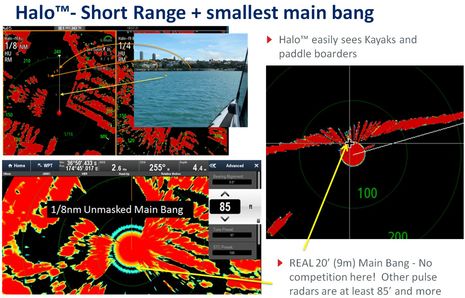 Of course, Simrad is proud of Halo’s near zero “main bang” (the area so close to your boat that the radar can’t receive returning pulses). I’ve never thought that this feature was a huge deal because actionable targets are usually further away and modern magnetron radars seem to be pretty quick anyway (shown above is a Raymarine SHD with only 85 feet obscured). But any and all situational awareness is a good thing, and I did see Halo image pelican butts at about 20 feet.
Of course, Simrad is proud of Halo’s near zero “main bang” (the area so close to your boat that the radar can’t receive returning pulses). I’ve never thought that this feature was a huge deal because actionable targets are usually further away and modern magnetron radars seem to be pretty quick anyway (shown above is a Raymarine SHD with only 85 feet obscured). But any and all situational awareness is a good thing, and I did see Halo image pelican butts at about 20 feet.
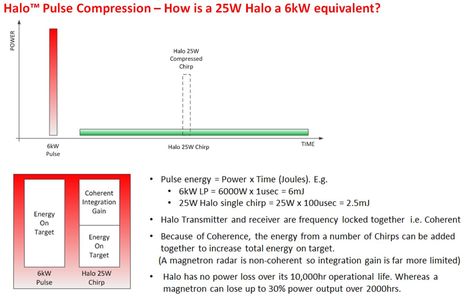 But the question I keep hearing is how can Halo see as far as a 6kW magnetron radar, and while Simrad has already hedged a bit with their “good to excellent” long range self-rating, here’s how it does what it does. Apparently, Halo’s compressed CHIRP pulses are so Coherent (in the radar engineering sense) that they “can be added together to increase total energy on target”…
But the question I keep hearing is how can Halo see as far as a 6kW magnetron radar, and while Simrad has already hedged a bit with their “good to excellent” long range self-rating, here’s how it does what it does. Apparently, Halo’s compressed CHIRP pulses are so Coherent (in the radar engineering sense) that they “can be added together to increase total energy on target”…
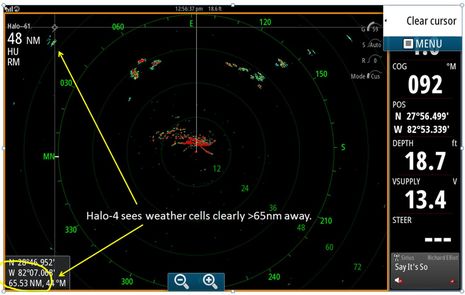 …and here’s one of the Proof of Performance screens that nicely complement the presentation Don showed me. Here’s a Halo-4 with a declared maximum range of 64NM imaging a weather cell at over 65NM. Note, though, that it’s in Custom mode and at least the gain has been manually set, and maybe the speed slowed down.
…and here’s one of the Proof of Performance screens that nicely complement the presentation Don showed me. Here’s a Halo-4 with a declared maximum range of 64NM imaging a weather cell at over 65NM. Note, though, that it’s in Custom mode and at least the gain has been manually set, and maybe the speed slowed down.
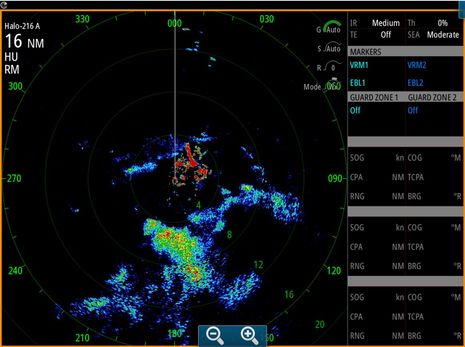 Here’s another weather screen that I particularly liked as one of my few gripes with 4G, and what I saw of Halo in Florida, is that they didn’t seem to use true color as well as competitors like Raymarine and Furuno. However, the use of color here to mark rain density seems excellent, and it’s being done automatically in Wx mode.
Here’s another weather screen that I particularly liked as one of my few gripes with 4G, and what I saw of Halo in Florida, is that they didn’t seem to use true color as well as competitors like Raymarine and Furuno. However, the use of color here to mark rain density seems excellent, and it’s being done automatically in Wx mode.
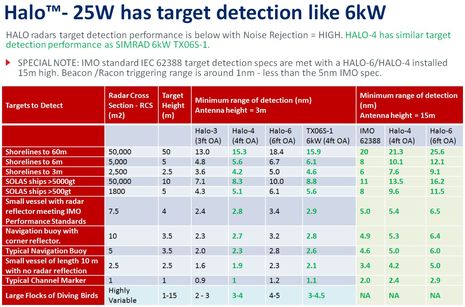 You may be pleased to know that this is the next to last diagram in this entry. It shows how the Halo models test against Simrad’s own TX06S 6kW 4-foot open-array. Note that the ability to see radar SART beacons and RACONs is a promised feature, not a shipping one, as discussed in the first Halo entry.
You may be pleased to know that this is the next to last diagram in this entry. It shows how the Halo models test against Simrad’s own TX06S 6kW 4-foot open-array. Note that the ability to see radar SART beacons and RACONs is a promised feature, not a shipping one, as discussed in the first Halo entry.
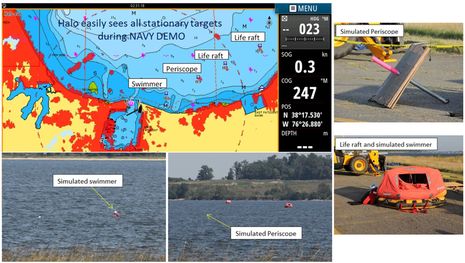 Apparently, Navico showed off Halo to the U.S. Navy at their big Naval Air Station Patuxent facility, and at least they got some neat testing images out of it. It’s not often that we get to see small target photos like these.
Apparently, Navico showed off Halo to the U.S. Navy at their big Naval Air Station Patuxent facility, and at least they got some neat testing images out of it. It’s not often that we get to see small target photos like these.
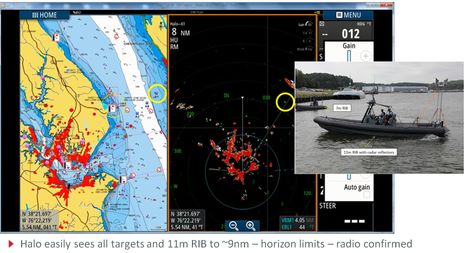 Also impressive is imaging a big RIB at about 9nm, though it did have a substantial radar reflector.
Also impressive is imaging a big RIB at about 9nm, though it did have a substantial radar reflector.
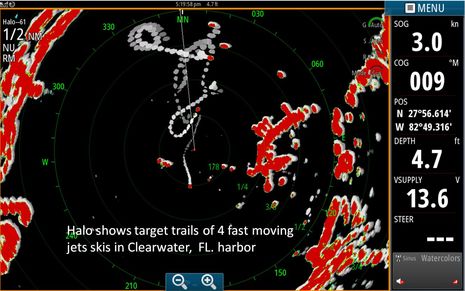 I’d guess that Don Korte captured this screen near his base in Tampa, Florida. It shows how Halo’s target trails mode, probably combined with high speed antenna rotation (48 rpm), can image goofball jet skiers.
I’d guess that Don Korte captured this screen near his base in Tampa, Florida. It shows how Halo’s target trails mode, probably combined with high speed antenna rotation (48 rpm), can image goofball jet skiers.
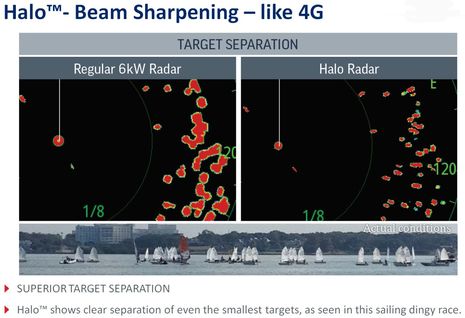 And here’s a good illustration of how the Halo (and 4G) Beam Sharpening feature can be useful, actually better than the off/low/med/high screen shown in the first Halo entry.
And here’s a good illustration of how the Halo (and 4G) Beam Sharpening feature can be useful, actually better than the off/low/med/high screen shown in the first Halo entry.
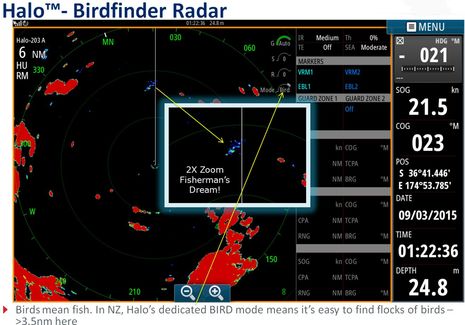 Most Halo testing happened in New Zealand, and this one shows effective Bird mode (and use of color)…
Most Halo testing happened in New Zealand, and this one shows effective Bird mode (and use of color)…
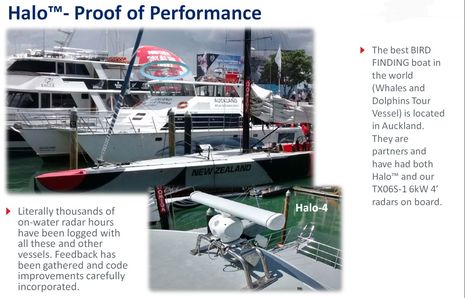 …while this one illustrates one of the test vessels. The presentation also shows numerous smaller vessels equipped with Halo alongside Furuno, Garmin, and Raymarine, but I think I’ve gone on long enough! The closing image is a Halo “bonus” slide that’s interesting and also reminded me of heavy clutter target detection diagrams I’ve seen for the Kelvin Hughes SharpEye. When I asked Don if Halo was possibly capable of the doppler technology SharpEye uses, or even just the ARPA that Furuno has managed to put in even its UHD radomes, he could barely contain himself. Suffice it to say that Halo likely has room to grow built in.
…while this one illustrates one of the test vessels. The presentation also shows numerous smaller vessels equipped with Halo alongside Furuno, Garmin, and Raymarine, but I think I’ve gone on long enough! The closing image is a Halo “bonus” slide that’s interesting and also reminded me of heavy clutter target detection diagrams I’ve seen for the Kelvin Hughes SharpEye. When I asked Don if Halo was possibly capable of the doppler technology SharpEye uses, or even just the ARPA that Furuno has managed to put in even its UHD radomes, he could barely contain himself. Suffice it to say that Halo likely has room to grow built in.


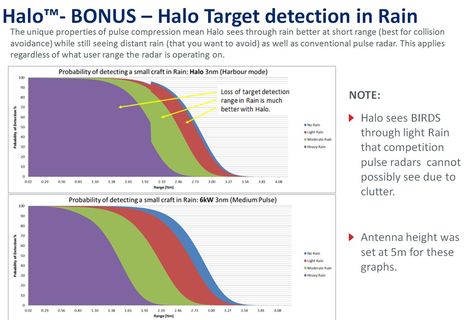
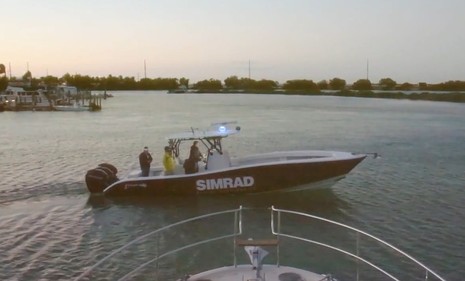
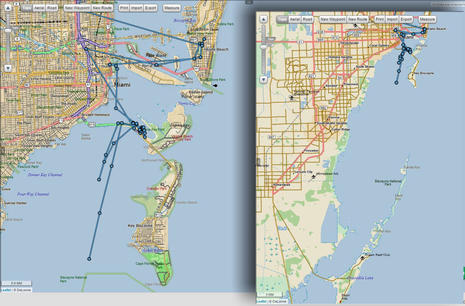
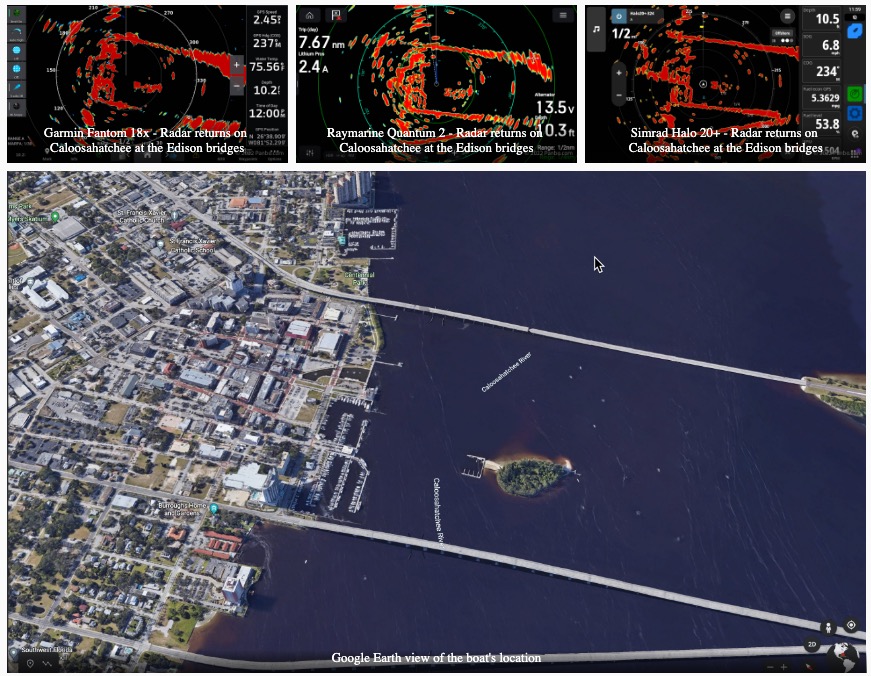
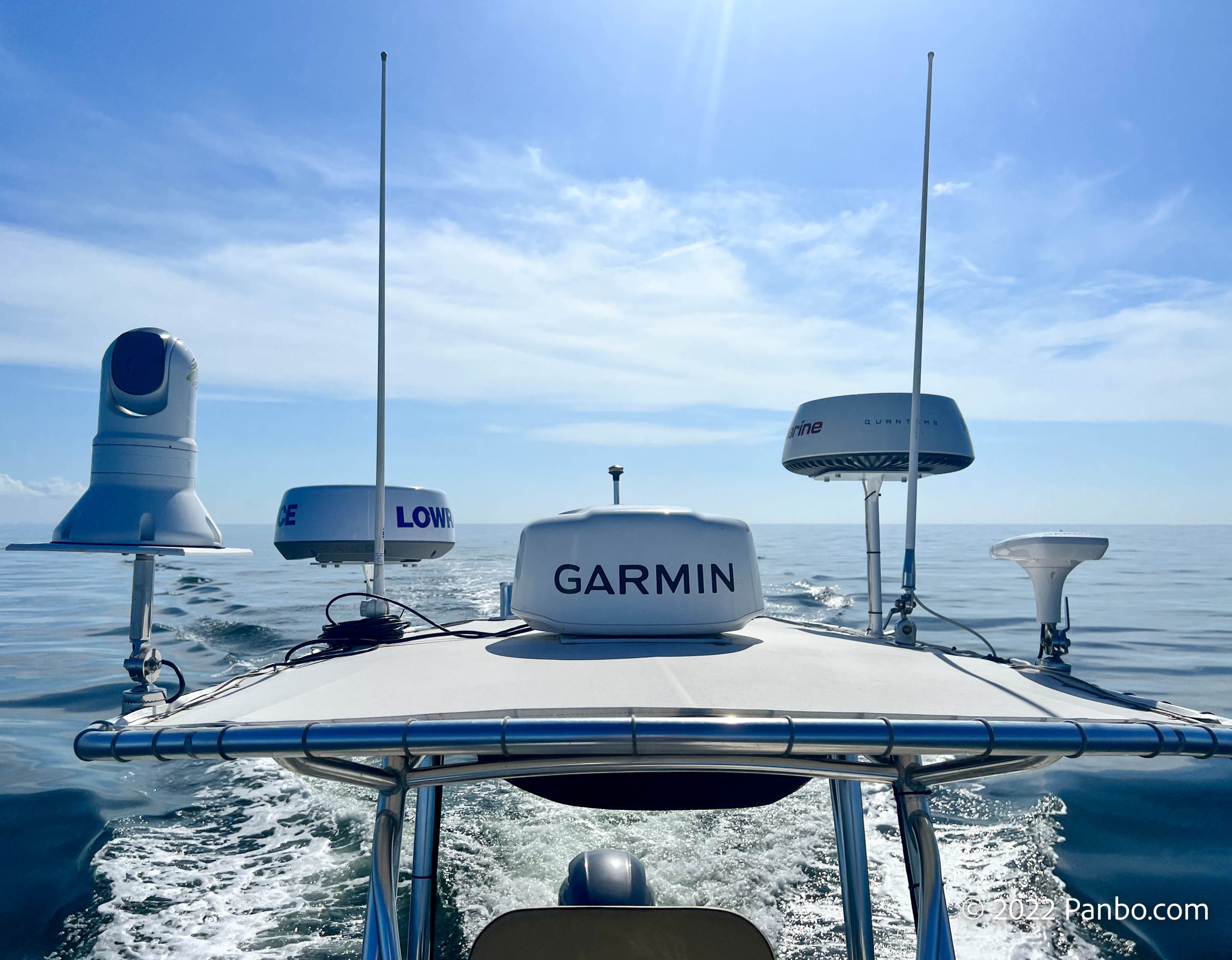








Ben,
Thanks for this, excellent information! Have you heard anything about their plans for releasing Halo support under the B&G name? Thanks…
Ben, you would never let me submit an entry this long 🙂
The level of excitement here is contagious, great slides, and explanation of how a combination of different transmissions are used together to cover all the ranges.
Very enlightening, thanks !
Thanks, Dan. I’m not sure that the presentation I have will ever become public or get coverage elsewhere, so I went large.
Anon, I have no idea if there will be a B&G branded Halo. I don’t think it would be hard to do, and maybe Zeus2 will even work fine with the Simrad Halo when it ships (I don’t know when), but the brands definitely do not promise interoperability. It may be up to customer demand and is probably a good question for dealers.
Ben,
Awesome presentation – almost the equivalent of attending a manufacturers training seminar! Plus, I learned (with a little help from Wikipedia) the definition of a radar mile, the abbreviation for micro-second, and how to create the Greek symbol “µ” in Word… 😉
Ben-
Well it has finally happened – a low cost recreational SS Pulse compression radar. I have to give kudos to the folks at Navico / Simrad. Use of GaN technology is very wise. It offers the very highest DC to RF efficiency and highest possible output power for a single device. That equates to reduced cost. I wanted to give a simple explanation of what is happening in the HALO.
The old saw of stretching out the pulse to provide time on target is true – but all you are doing is getting average power to be nearly equivalent to the Magnetron peak power. For example 1uSec Pulse repeated every 1mSec = 0.001 duty factor x 4000W = 4 watts average. The HALO example would be 96uSec / 1mSec = 0.096 x 25W =2.4W average. So the average power on target is nearly the same as the 4Kw system. I don’t know all the details of the real system Pulse rates but you get the idea.
But if you use a pule length of 96uSec you have a range resolution of 8Nmi! The range resolution is recovered by the Linear Frequency Modulation “Chirp” that produces a range bin that is more usable and provides closer to meters or feet of resolution rather than miles.
It is also important to recognize that standard magnetron pulse radars also require multiple pulse lengths and pulse repetition rates to cover the entire range extent and blind ranges.
Note that the Garmin GWX70 Airborne weather radar is also a pulse compression system – following the lead of the Honeywell RDR4000 introduced over 10 years ago. I frankly have been wondering about when Garmin will have its own Marine SS Pulse Compression system as well.
The most recent IEC / IMO regulations encourage the development of SS pulse compression radars to replace the magnetron systems. They offer far greater potential for long term performance improvements and far higher reliability than Magnetron systems.
I love the Ethernet data interface. The new digitally synthesized Pulse Compression waveform no longer needs the old fashioned “t0” timing reference pulse and odd ball proprietary data interface. Now that the data can be encoded in blocks along detection radials and the data can be readily transmitted in digital streams. Given the “code” to the data block format any MFD could be made to display that radar image.
I guess this is a question for Simrad. Will Halo ever show up as a dome radar for mounting on the mast of a sailboat? I’m beginning to think that the technology just won’t fit in such a small (dome) housing.
GREAT to see more “mil-grade” technology seeping out into civilian world!
http://www.macom.com/files/live/sites/ma/files/contributed/Gan/ganmanifesto.pdf
GaN (Gallium Nitride) technology is finally coming of age, but it’s been a long, long gestation. The problem is that the crystal structure of GaN doesn’t match much of anything to use as a substrate. Theoretically, Silicon Carbide (SiC) comes closest to matching, but making SiC wafers has proven to be incredibly difficult, not the least of which because of the insane temperatures required and that the techniques used to make boules from which to slice wafers doesn’t work well enough to make the economics attractive. So GaN-on-SiC was the stuff of legends told by non-existent people from non-existent places doing unknowable things. GaN-on-SiC parts could be made by gnomes commanding dark forces in secret lairs if cost was no object and you had more patience than money.
The other path was to figure out how to build GaN transistors by adapting (i.e., coercing) existing semiconductor manufacturing techniques to work “well enough”. A company originally named Nitronex developed the technology to build GaN power transistors on silicon wafers. The trick was developing a recipe of different materials deposited in a stack of layers of varying thickness on the silicon substrate which would result in an adequate match for the GaN crystal structure grown on the top of the stack. By their own admission, the Nitronex parts would probably never reach the stratospheric specifications of GaN-on-SiC parts, but they could make the parts in quantity at a price less than the GNP of a small country.
As is often the case, the GaN business was highly fragmented with various startups competing against each other when they were actually addressing different segments of the microwave power-transistor business. M/ACOM appears to have stepped in and is busily collecting all the various pieces and making some sense of the product lines. GaN-on-Si for volume production (aka “price sensitive” applications) and GaN-on-SiC for customized devices that squeeze every microgram of performance from the technology (civilians need not apply!).
I”ve been watching Nitronex for about a decade and while I turned down a chance for the day-job to invest in the company, I’m *delighted* to see that they have survived to finally find an understanding “Forever Home” and that the work is going mainstream.
Bravo! Finally, we’re looking at a solid state radar for our market that invites important benefits. Doppler presentation of squalls, for example. Congratulations to the Simrad team.
Wait and look to Furuno on SS Radar’s in the non-Far consumer line, as it will be coming at some point in the distant future. With the exception of the problems associated with NN3D, Furuno does an exceptional job at launching products that are tested and true. I wish I could say the same for Navico (not the wonderful Simrad pre Navico).
Most products out of Navico are sent-out to the market premature and prone to issues, working out the quirks at the customer/installers expense. Navico still hasn’t worked out the various bugs on their current NSE/NSO scanners. Why one would ever jump into buying the Halo would be a colossal mistake in my opinion, only as a result of the history with Navico.
I have zero alliance to either company but can only tell you from personal experience that Simrad is more often a headache and Furuno is not.
I’d wait AT LEAST one year after these radars hit the market to buy in.
Good luck.
Its been over one year, where is the Tsunami of negative posts?
Not one. I rest my case.
I am trying to fine a rotating base for the 2018 halo compresion boat was being transported and th base hit something and cracked
Still operational but need the base and directions on how to remove rotating base
Any one
Thanks